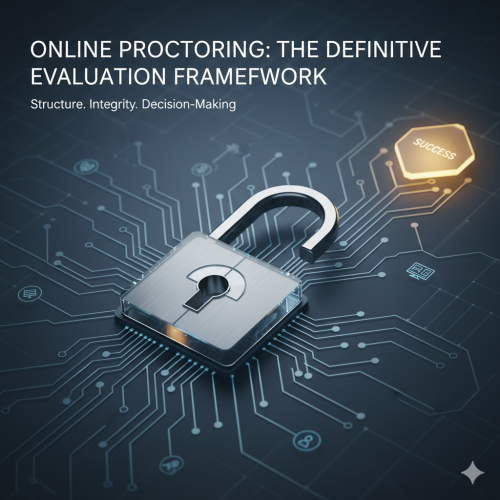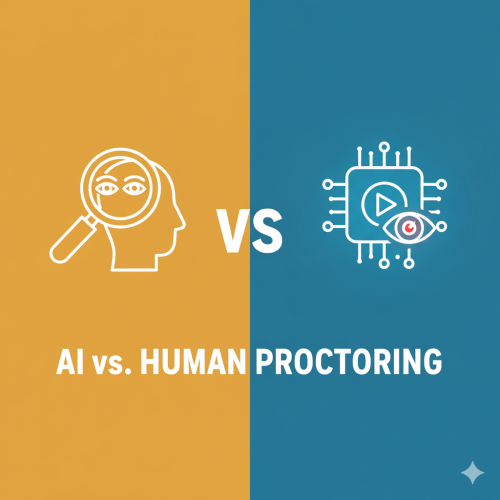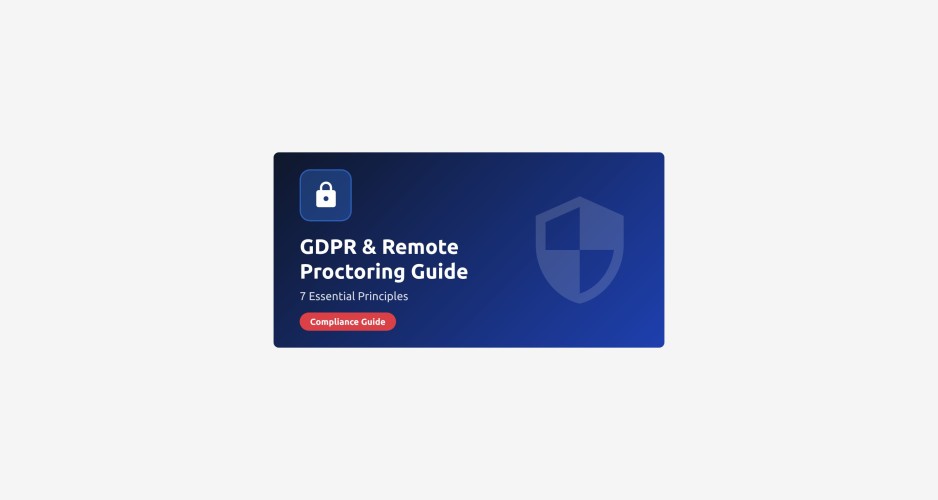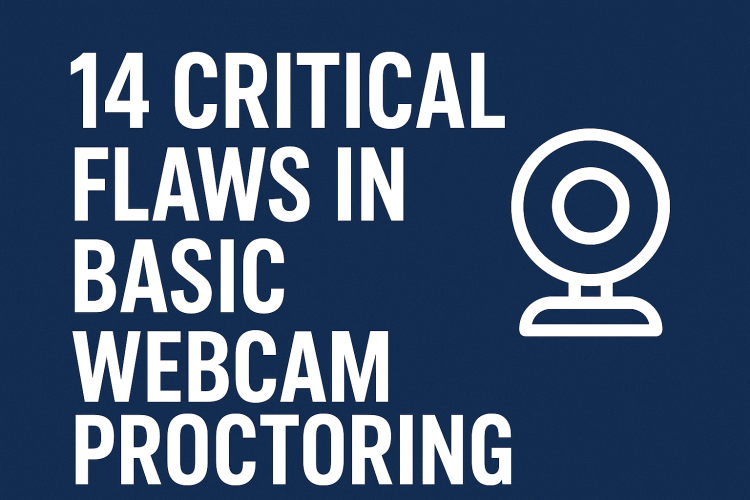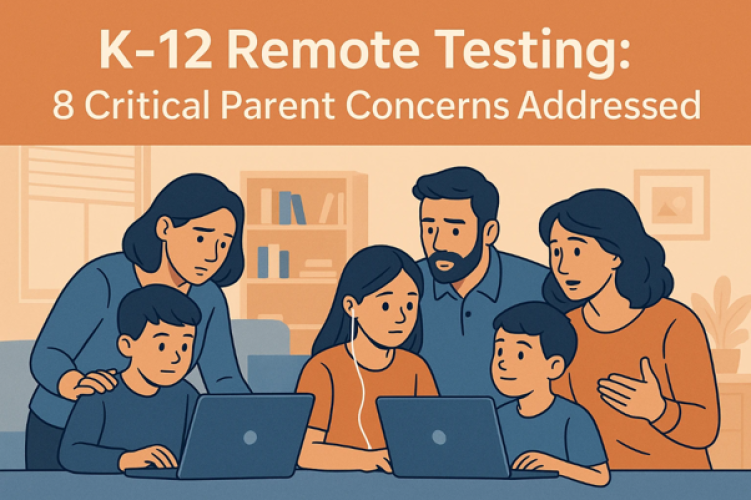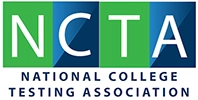Are you an EdTech company or an assessment provider navigating the complexities of remote proctoring? Do you worry about keeping student data safe and staying on the right side of privacy laws?
Remote proctoring has become vital for online exams and assessments. It helps ensure fairness and prevent cheating. But it also involves collecting personal data, sometimes very sensitive information. This brings a big challenge: how do you balance exam security with strict data privacy rules like the General Data Protection Regulation (GDPR)?
GDPR is a powerful law from the European Union. It protects the personal data of individuals in the EU and European Economic Area (EEA). If your organization deals with data from anyone in these regions, GDPR applies to you, no matter where your company is based. Breaking these rules can lead to huge fines and damage your reputation.
This article will guide you through the 7 core GDPR principles. We will show you exactly how each principle applies to remote proctoring. You will get practical tips and strategies. Our goal is to help you build a proctoring system that is both secure and compliant while earning trust from your users.
Understanding the Foundation: GDPR's 7 Data Protection Principles
The GDPR is built on seven fundamental principles. Think of them as the pillars of data protection. For EdTech and assessment companies, understanding these principles is crucial for building a compliant remote proctoring solution. Let us break down each one and see how it fits into your proctoring world.
A. Lawfulness, Fairness, and Transparency: The Cornerstone of Trust
This principle means you must process personal data legally, fairly, and openly. For remote proctoring, it means you must have a valid legal reason to collect data. You also need to be clear with test-takers about what data you collect, why, and how you will use it.
What it means for proctoring: You cannot just start recording. You need a lawful basis. This is often "consent" or "legitimate interest." Your privacy policies must be easy to
understand. Test-takers should know exactly what they are agreeing to. Actionable steps:
Create transparent privacy notices. These should be specific to proctoring. Clearly state what data is collected (video, audio, screen share, biometrics). Explain the purpose of collection (e.g., identity verification, preventing cheating). Tell them how long data will be stored and who will have access.
Use clear consent mechanisms. Make sure test-takers actively agree before proctoring starts.
B. Purpose Limitation: Why Are We Collecting This Data?
You should only collect data for specified, explicit, and legitimate purposes. Once collected, you cannot use that data for a different, unrelated purpose. For proctoring, this means your data collection must be solely focused on ensuring exam integrity.
What it means for proctoring: If you collect video to check for cheating, you cannot then use that video for marketing, or for analyzing student behavior patterns unrelated to the exam. Each piece of data must have a clear, stated purpose tied to the proctoring process.
Actionable steps:
Clearly define the specific purposes for collecting video, audio, screen shares, or biometric data in your proctoring policy.
Avoid collecting data that goes beyond these defined purposes.
Do not reuse proctoring data for unrelated research or development without new, specific consent.
C. Data Minimization: Less is More (and Safer)
This principle requires you to collect only the data that is absolutely necessary for your stated purpose. Do not collect more than you need. The less data you collect, the lower your risk of a data breach.
What it means for proctoring: This is crucial. If a full-room scan is not needed, do not demand it. If keystroke analytics are not essential for your exam, do not collect them. For example, if identity verification only needs a photo ID, do not also collect biometric facial scans unless strictly necessary and justified.
Actionable steps:
Evaluate each data point collected during proctoring. Ask if it is truly necessary for exam integrity.
Implement selective monitoring. For instance, only flag suspicious activities instead of continuous human review for all sessions.
Consider options like browser lockdown without full desktop monitoring if exam type allows.
D. Accuracy: Ensuring Data Integrity
Personal data must be accurate and kept up to date. This means taking reasonable steps to correct or delete inaccurate data without delay. In proctoring, this applies to identifying the correct test-taker and accurate flagging of unusual behavior.
What it means for proctoring: You need robust identity verification methods. This ensures the person taking the test is who they say they are. If an AI flags something incorrectly, there should be a process to review and correct that information.
Actionable steps:
Implement strong ID verification processes. Use multiple checks where appropriate. Allow test-takers to correct inaccurate personal details in their profiles. Establish procedures for human review of AI-flagged incidents to ensure accuracy before taking action.
E. Storage Limitation: How Long is Too Long?
You should not keep personal data for longer than necessary for the purposes for which it was collected. For proctoring recordings and related data, this means setting clear retention periods.
What it means for proctoring: Do you really need to keep a proctoring video for five years? Probably not. Once the exam results are final and any appeal periods are over, the data might no longer be needed. The average cost of a data breach globally was $4.45 million USD in 2023. The less data you hold, the lower your risk if a breach occurs.
Actionable steps:
Establish clear, justifiable data retention policies for proctoring recordings and related logs.
Automate deletion schedules for data that has passed its retention period. Document your legal justification for chosen retention periods. Consider exam appeals policies, regulatory requirements, or internal investigations.
F. Integrity and Confidentiality (Security): Protecting Sensitive Data
This principle is about protecting personal data against unauthorized or unlawful processing, accidental loss, destruction, or damage. It requires you to implement appropriate technical and organizational measures.
What it means for proctoring: Proctoring often involves sensitive data like biometric identifiers and video of private spaces. This data needs top-tier security. This means strong encryption, secure storage, and strict access controls.
Actionable steps:
Use end-to-end encryption for all proctoring data, both in transit and at rest. Implement strict access controls. Only authorized personnel should view proctoring recordings.
Regularly audit your security systems. Conduct penetration testing.
Have a robust data breach response plan in place.
G. Accountability: Demonstrating Compliance at Every Turn
You are responsible for complying with all GDPR principles. You must also be able to demonstrate that compliance; this means having proper records, policies, and procedures in place.
What it means for proctoring: It is not enough to say you are GDPR compliant. You must prove it. This involves documenting your decisions, conducting assessments, and having clear internal policies.
Actionable steps:
Maintain detailed records of your data processing activities for proctoring. Conduct Data Protection Impact Assessments (DPIAs) for your proctoring solutions. Appoint a Data Protection Officer (DPO) if required. Ensure staff receive regular privacy training.
Have a clear process for reviewing and updating your GDPR policies annually.
Key Compliance Challenges & Solutions for Remote Proctoring
GDPR compliance in remote proctoring is complex. EdTech and assessment companies face specific challenges. Here is how to tackle them.
A. Lawful Basis for Processing: Consent vs. Legitimate Interest
Choosing the correct legal reason to process data is fundamental. For proctoring, it is often a choice between explicit consent and legitimate interest.
When to use which for proctoring data: Explicit consent means the test-taker freely and clearly agrees to the processing. This is often necessary for sensitive data, like biometrics or extensive video monitoring. Legitimate interest can apply if the processing is necessary, proportionate, and you can show a clear benefit that outweighs the individual's rights. However, for proctoring, especially with sensitive data, relying on legitimate interest can be risky and often less preferred by supervisory authorities. Studies show significant student discomfort with certain proctoring methods due to privacy concerns, reinforcing the need for clear consent.
Best practices for obtaining explicit consent:
Make consent requests separate from other terms and conditions.
Ensure consent is specific, informed, and unambiguous. No pre-ticked boxes. Allow test-takers to withdraw consent easily.
B. Data Protection Impact Assessments (DPIAs) for Proctoring
A DPIA is a risk assessment. It helps identify and minimize data protection risks before you start a new data processing activity. GDPR mandates DPIAs for high-risk activities.
When is a DPIA required? Remote proctoring, especially with new technologies like AI, biometric data, or large-scale processing, almost always requires a DPIA. This is because it often involves sensitive data and systematic monitoring.
Key elements of a proctoring DPIA:
A detailed description of the proctoring process.
An assessment of the necessity and proportionality of the data processing. An evaluation of the risks to individuals' rights and freedoms.
Measures planned to address those risks and demonstrate compliance.
C. Managing Third-Party Proctoring Vendors (Data Processors)
Many organizations outsource proctoring. When you use a third-party vendor, they become a 'data processor' and you remain the 'data controller.' You are still responsible for their compliance.
Due diligence checklist for selecting compliant vendors:
Check their GDPR compliance statements and certifications.
Inquire about their data security measures (encryption, access controls). Understand their data retention policies and where they store data.
Ask about their process for handling data subject requests.
Crucial elements of Data Processing Agreements (DPAs): A DPA is a legally binding contract. It defines the responsibilities between you (the controller) and the proctoring vendor (the processor).
Explicitly state the subject matter, duration, nature, and purpose of processing. Detail the types of personal data and categories of data subjects.
Require the processor to process data only on your documented instructions. Obligate the processor to implement strong security measures.
Outline procedures for data breaches and data subject requests.
D. Cross-Border Data Transfers: Navigating Global Assessments
Transferring personal data of EU individuals outside the EU/EEA is heavily regulated. This is a major concern for global EdTech platforms.
Understanding Schrems II and its impact: The Schrems II ruling invalidated the EU-US Privacy Shield, making data transfers to the US more challenging. This means organizations need stronger safeguards.
Reliance on Standard Contractual Clauses (SCCs) and transfer impact assessments: SCCs are a common mechanism. However, they must be supplemented with a Transfer Impact Assessment (TIA). A TIA evaluates if the destination country's laws (e.g., surveillance laws) undermine the protections offered by SCCs.
E. Handling Data Subject Rights Requests (DSARs) for Proctoring Data Individuals have rights under GDPR, including the right to access, rectify, or erase their data.
How to respond to access, rectification, and erasure requests for proctoring recordings:
Have a clear process to identify and retrieve relevant proctoring data when a request comes in.
Provide data in a concise, transparent, intelligible, and easily accessible form. Implement systems to redact or delete specific recordings or data points without affecting exam integrity or other individuals' data.
Respond to requests within the legal timeframe (usually one month).
Building Trust: Transparency and Best Practices
Compliance is not just about avoiding fines; it is about building trust. Transparent practices can turn potential privacy concerns into a competitive advantage.
A. Crafting a Clear and Comprehensive Proctoring Privacy Policy
Your privacy policy is your promise to test-takers about how you handle their data. It needs to be precise, easy to understand, and readily available.
What to include: Be specific about the data collected (e.g., "video of face and upper torso," "audio from microphone," "screen activity"). Detail the purpose for each type of data. Explain data retention periods, security measures, and data subject rights. Also, mention if AI or biometric analysis is used.
Language considerations: Avoid legal jargon. Use plain language. Provide information in layers, with a summary and then more detail, to enhance readability. This helps ease privacy concerns, which are expressed by a significant percentage of individuals, often 70% or more.
B. Training Staff and Educating Test-Takers
A well-informed team and educated users are your best defense against privacy breaches and misunderstandings.
Fostering a culture of privacy: Train all staff involved in proctoring, from technical support to review teams, on GDPR principles and best practices. Educate test-takers before the exam about the proctoring process, what data is collected, and why. Provide a quick guide or FAQ.
C. Privacy by Design & Default in Proctoring Solutions
Integrate privacy into your proctoring solutions from the very beginning. Do not add it as an afterthought.
Integrating privacy from the outset: Design systems to collect the minimum necessary data (data minimization). Ensure strong security is built in, not bolted on. Offer privacy enhancing options by default, where feasible. For example, automatically delete recordings after a set period unless there's a valid reason for extended retention. This proactive approach supports robust GDPR proctoring compliance.
The Cost of Non-Compliance: Why It's Not Worth the Risk
Ignoring GDPR is a costly mistake. The financial, reputational, and legal consequences can be severe for EdTech and assessment companies.
A. Financial Penalties
GDPR fines are substantial. Since May 2018, fines exceeding €4 billion have been issued. The largest fine to date was €1.2 billion against Meta Platforms Ireland Limited. This highlights the severe financial risk of non-compliance, especially concerning cross-border data transfers.
B. Reputational Damage & Loss of Trust
A data breach or a public complaint about privacy can severely damage your brand. In the education sector, trust is paramount. Students, parents, and institutions choose providers they trust. A privacy incident can lead to a loss of enrollments, contracts, and partnerships.
C. Legal Challenges & Enforcement
Beyond fines, non-compliance can lead to legal actions from individuals or consumer protection groups. Data protection authorities (DPAs) are actively enforcing GDPR. They can impose strict audits, processing restrictions, or even temporary bans on data processing activities until compliance is met.
Conclusion: Proactive Compliance as a Competitive Advantage
Navigating GDPR requirements for remote proctoring might seem daunting. However, embracing robust data protection is not just a legal obligation; it is a strategic advantage. By prioritizing GDPR proctoring compliance, you build trust with your test-takers and partners. You also protect your organization from significant financial and reputational risks.
A. Recap of the 7 Essentials for Proctoring Success
Remember the 7 data protection essentials: lawfulness, fairness, and transparency; purpose limitation; data minimization; accuracy; storage limitation; integrity and confidentiality; and accountability. Each plays a vital role in creating a privacy-first proctoring solution.
B. Your Next Steps: Building a Robust GDPR Proctoring Framework
Start by auditing your current proctoring processes. Conduct a Data Protection Impact Assessment (DPIA) if you have not already. Review your privacy policies and Data
Processing Agreements (DPAs) with third-party vendors; invest in staff training and transparent communication with your users. The global EdTech market is growing rapidly, and compliant solutions are in high demand.
C. Call to Action
Ready to ensure your remote proctoring solutions are fully GDPR compliant and instill confidence? Learn more about Proctor360's GDPR-compliant proctoring solutions and how we can help you safeguard student data while maintaining exam integrity.
FAQs: GDPR & Remote Proctoring Compliance
Q1: Is obtaining explicit consent from every test-taker mandatory for remote proctoring under GDPR, especially when we use AI or biometrics?
Not always mandatory for all data, but strongly recommended, especially for sensitive data. For general personal data in proctoring, you might rely on "legitimate interest" if it is strictly necessary and proportionate. However, for "special categories" of data like biometrics (e.g.,
facial recognition), or if your processing involves automated decision-making with legal effects, then explicit consent is usually the safest and often required lawful basis.
It is crucial that any consent obtained is specific, informed, and freely given. Test-takers must understand what they are agreeing to and have the option to withdraw consent. You should also offer alternatives where possible.
Q2: How can we ensure that proctoring data (like video recordings or biometric scans) of EU students isn't illegally transferred or stored outside the EU, given the complexities of international data transfers?
International data transfers are a major challenge. First, determine where your proctoring data is stored and processed globally. If data leaves the EU/EEA, you need a valid transfer mechanism.
Standard Contractual Clauses (SCCs) are the most common. However, they must be supplemented by a Transfer Impact Assessment (TIA). This assessment checks if the destination country's laws (e.g., government surveillance) could undermine SCC protections. If the destination country cannot guarantee equivalent protection, additional safeguards or alternative solutions might be needed. Using EU-based servers and processing for EU student data can simplify compliance.
Q3: What are the specific data minimization strategies we can implement in our proctoring process to reduce our GDPR risk without compromising exam integrity?
Data minimization means collecting only essential data. Strategies include:
Limited Recording: Instead of continuous video, consider 'event-based' recording where only suspicious activities are flagged and recorded, minimizing general footage.
Restricted Monitoring Scope: If only the student's face and screen are necessary, avoid full room scans or extensive audio monitoring unless absolutely justified. Shorter Retention: Delete recordings as soon as their purpose is fulfilled (e.g., after grading and appeals period).
Anonymization/Pseudonymization: Where possible, anonymize or pseudonymize data for analysis that does not require direct identification.
Regularly review your proctoring features. Ask if each data point truly contributes to exam integrity. The less sensitive data you collect and retain, the lower your risk of a breach.
Q4: If a student requests access to or deletion of their proctoring recording, what are our obligations under GDPR, and what's the most efficient way to handle these requests?
Under GDPR, students have several "Data Subject Rights," including the right to access their data (Article 15) and the right to erasure (Article 17). You must respond to these requests without undue delay, typically within one month.
To handle requests efficiently:
Establish a clear, documented process for receiving and tracking DSARs. Ensure your system can easily locate and retrieve specific proctoring recordings or related data for an individual.
If deleting data, ensure it is permanently removed from all systems and backups. This includes any third-party processors you use.
Communicate clearly with the student throughout the process.
You may deny a request for erasure if you have a compelling legal reason to retain the data (e.g., ongoing investigation of academic misconduct). This must be clearly justified.
Q5: Beyond just legal compliance, how can we communicate our GDPR compliant proctoring practices to students and parents in a way that
builds trust and addresses their privacy concerns, rather than creating more anxiety?
Transparency is key to building trust. Use plain, easy-to-understand language. Avoid legal jargon in your communications.
Create a dedicated "Proctoring Privacy FAQ" page. Address common concerns directly and clearly.
Provide clear, concise information before the exam about what data is collected, why, how it's used, and how long it's kept.
Emphasize the security measures in place. Explain how data is protected. Highlight the benefits of proctoring for academic integrity and fairness for all students.
Offer a clear point of contact for privacy questions or concerns.
Show that you take privacy seriously. Do not just meet the minimum legal requirements; strive to exceed expectations in transparency and care for student data. This builds a positive reputation and competitive advantage.
